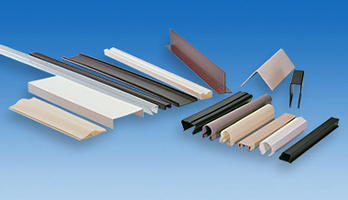Why plastic extrusion is ideal for mass production
Understanding the Basics and Applications of Plastic Extrusion in Modern Manufacturing
In the world of modern-day production, the technique of plastic extrusion plays a critical role - plastic extrusion. This complex process, including the melting and shaping of plastic via specialized dies, is leveraged throughout numerous markets for the production of varied items. From auto components to durable goods packaging, the applications are large, and the possibility for sustainability is equally excellent. Deciphering the principles of this procedure discloses real versatility and potential of plastic extrusion.
The Principles of Plastic Extrusion Refine
While it might appear complex, the fundamentals of the plastic extrusion procedure are based on fairly simple principles. It is a manufacturing process where plastic is melted and after that shaped into a continuous account with a die. The plastic extrusion process is thoroughly used in numerous sectors due to its cost-effectiveness, adaptability, and effectiveness.
Various Kinds of Plastic Extrusion Strategies
Building upon the fundamental understanding of the plastic extrusion process, it is essential to explore the various techniques involved in this manufacturing technique. The 2 main strategies are profile extrusion and sheet extrusion. In profile extrusion, plastic is melted and developed right into a continuous profile, frequently used to produce pipelines, poles, rails, and home window frames. In contrast, sheet extrusion produces large, flat sheets of plastic, which are typically further processed into items such as food product packaging, shower drapes, and automobile components. Each strategy requires specialized machinery and specific control over temperature and stress to make certain the plastic preserves its form throughout air conditioning. Recognizing these strategies is key to utilizing plastic extrusion successfully in modern-day production.

The Role of Plastic Extrusion in the Automotive Industry
A frustrating majority of components in contemporary cars are products of the plastic extrusion procedure. This procedure has transformed the auto market, changing it into a more effective, affordable, and versatile manufacturing field. Plastic extrusion is mostly utilized in the production of numerous automobile components such as bumpers, grills, door panels, and dashboard trim. The procedure supplies an attire, regular result, enabling suppliers to create high-volume get rid of fantastic accuracy and marginal waste. The lightness of the extruded plastic parts adds to the overall decrease in car weight, improving gas performance. check my source The sturdiness and resistance of these components to heat, cold, and impact improve the long life of automobiles. Thus, plastic extrusion plays an essential duty in automobile production.

Applications of Plastic Extrusion in Durable Goods Production
Beyond its significant effect on the automobile sector, plastic extrusion shows just as effective in the realm of consumer goods manufacturing. This process is essential in producing a vast array of items, from food product packaging to family home appliances, playthings, and even medical gadgets. The flexibility of plastic extrusion enables makers to design and create intricate shapes and sizes with high precision and performance. Due to the recyclability of several plastics, extruded parts can be recycled, decreasing waste and expense (plastic extrusion). The adaptability, flexibility, and cost-effectiveness of plastic extrusion make it a preferred option for several consumer goods producers, contributing dramatically to the sector's development and technology. The ecological ramifications of this widespread usage call for cautious factor to consider, a topic to be reviewed better in the succeeding area.
Ecological Effect and Sustainability in Plastic Extrusion
The prevalent usage of plastic extrusion in manufacturing welcomes scrutiny of its environmental effects. As a procedure that often makes use of non-biodegradable materials, the environmental impact can be substantial. Power consumption, waste manufacturing, and carbon exhausts are all issues. Nevertheless, market advancements are enhancing sustainability. other Reliable equipment reduces energy use, while waste management systems reuse scrap plastic, lowering basic material needs. In addition, the growth of eco-friendly plastics offers an extra eco-friendly choice. Regardless of these enhancements, further development is needed to mitigate the environmental impact of plastic extrusion. As culture leans towards sustainability, suppliers must adapt to continue to be sensible, stressing the significance of constant research study and innovation in this field.
Verdict
To look here conclude, plastic extrusion plays a crucial role in contemporary manufacturing, particularly in the automobile and durable goods industries. Its adaptability enables the production of a wide variety of elements with high accuracy. Furthermore, its possibility for recycling and growth of naturally degradable products provides a promising opportunity in the direction of sustainable practices, consequently addressing environmental problems. Comprehending the basics of this process is essential to maximizing its applications and benefits.

The plastic extrusion procedure is thoroughly utilized in different sectors due to its adaptability, cost-effectiveness, and performance.
Building upon the basic understanding of the plastic extrusion procedure, it is essential to explore the various strategies involved in this manufacturing approach. plastic extrusion. In contrast, sheet extrusion develops large, level sheets of plastic, which are commonly additional processed into items such as food packaging, shower curtains, and vehicle components.A frustrating majority of components in modern-day cars are items of the plastic extrusion procedure